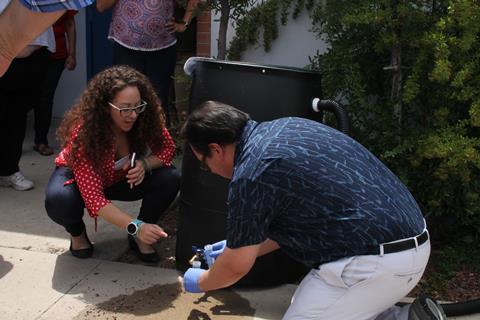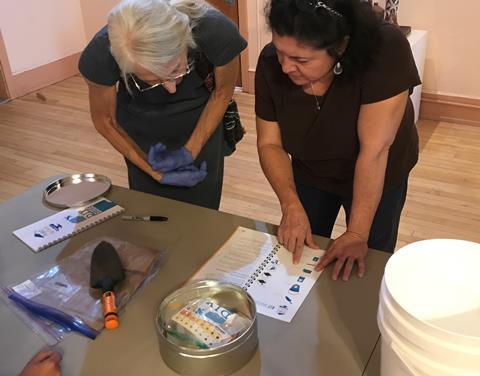Monitoring rainwater quality in Arizona

A 2016 paper revealed that four billion people, or close to two-thirds of the world’s population, experience severe water scarcity for at least one month in 12, with half a billion people facing these conditions continuously. In March of this year, a UN report into progress on Sustainable Development Goal 6, ‘clean water and sanitation for all’, has acknowledged that progress towards meeting this goal by the target of 2030 is ‘off track’ and that ‘we need to do more, much more quickly’.
In the US state of Arizona, Project Harvest is empowering participants to take matters into their own hands, by supporting them to collect and conserve water through rainwater harvesting and then monitor the quality of these supplies.
Monica Ramirez-Andreotta is director of Project Harvest and an associate professor for soil, water and environmental science at the University of Arizona. She explained how the idea emerged from discussions with community partners and as part of the Gardenroots citizen science project, which centred on the use of gardens as a hub for environmental health research. ‘People started to ask about whether they can use harvested rainwater to irrigate crops and foods that they would be growing, and they asked about what the quality of harvest rainwater was.’
Listening to the community
These discussions led Ramirez-Andreotta to complete a community needs assessment, which in turn inspired her and her team at the University of Arizona and Sonora Environmental Research Institute to create Project Harvest.
‘Communities brought that research question to light, as well as my colleagues on campus who are very much concerned about rainwater quality, particularly because in the city of Tucson we have a rebate program,’ she says. ‘And so, it was this nice blending of community concern with some of the interests of people on campus.’
There are now almost 200 participants in Project Harvest from four different communities in Arizona. The team includes not only scientists and students from a diversity of backgrounds – including analytical chemistry, geochemistry, environmental science and public health – but crucially community health workers, or promotora, who serve as knowledge brokers and a liaison between the university and the community.

Ramirez-Andreotta explains that the promotora are a key part of the project’s peer education strategy, as they are from the same place as the participants and hence share similar backgrounds and experience: ‘They’re trusted and have a relationship with the families and people in the area.’
The model and these relationships are particularly important because the project includes people from underserved areas of Arizona. ‘When we look at the demographics of the participants, over 50% are low income, over 50% do not have a college degree and over 50% identifies as a person of colour with the majority (42%) being Latinas/os/xs and Hispanic,’ says Ramirez-Andreotta.
Important too is Ramirez-Andreotta’s role as a ‘cultural knowledge breaker’. ‘I’m serving communities in which I’m coming from. I have spent a tremendous amount of time building relationships and trust and partnerships in these spaces and working with environmental justice communities or communities that would neighbour resource extraction or ongoing pollution.’
DIY
Participant roles aren’t limited to the collection of water samples. The lab group also uses kits to analyse the water for contaminants such as arsenic and E. coli and submits its results to university researchers. For Ramirez-Andreotta, the learning outcomes of the project are just as important as the water quality data collected, especially when the skills are transferable.
‘We asked if participants felt that the visualisations used in Project Harvest for the past two years helped them interpret Covid data,’ says Ramirez-Andreotta. ‘And we had people agree and strongly agree at a noteworthy value that the visualisations that we use in Project Harvest helped them interpret the visualisations and data visualisations used to talk about the pandemic.’
The visualisations are a key part of the ‘community-first’ reporting model, where project participants are the first to view the data that they have contributed to, following analysis by the team. Materials are provided in a digestible format, in multiple languages, and are presented as part of community data-sharing events.
‘We’re not waiting for the whole peer review process,’ explains Ramirez-Andreotta. ‘We’re doing internal review of the data, getting it into the hands of the participants, as fast as we can, and ensuring that they have the tools they need to make a decision about “is this water safe or not?”, “are my soils safe?” or “are my foods safe to continue to consume?” by providing comparative values.’
The team has found that participants are successfully interpreting the data and then modifying their behaviour to protect their families.
‘Anybody can be a scientist, we’re all scientists,’ says Ramirez-Andreotta. I agree, and think there’s a lot to be learnt from Project Harvest’s approaches.












No comments yet